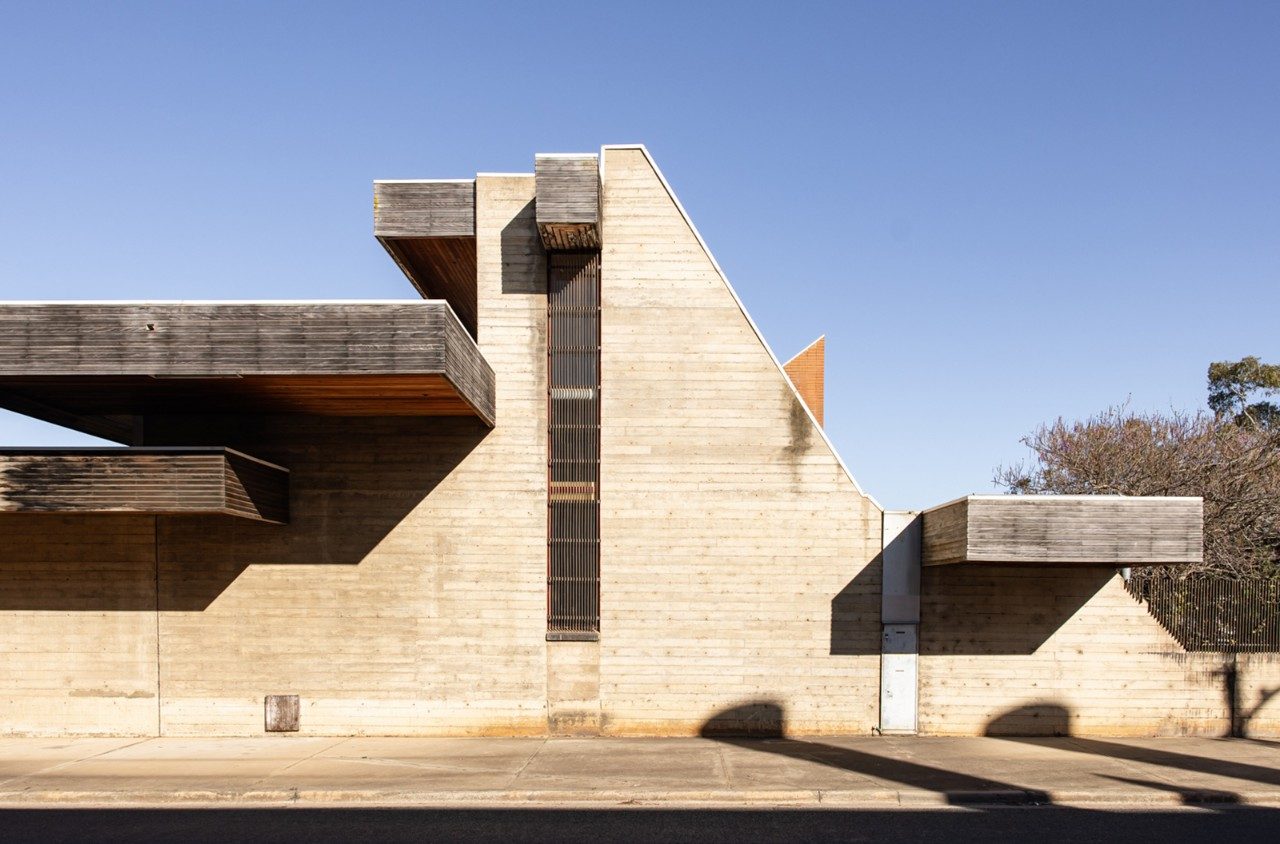We’ve Found the Best Architectural Buildings in Canberra

A university building is not a typical place to launch a tour of a city’s architectural highlights. But the Menzies Library at the Australian National University (ANU) is a cuboid marvel of concrete and pink-grey stone, influenced by Frank Lloyd Wright, one of the most visionary architects of the 20th century. And if you tilt your head, you can see light being scrambled by the sculptural bronze Lyndon Dadswell screens that swirl across its windows.
Don’t know much about architecture at all? This grassy campus at the edge of Canberra’s hip Acton café district is the perfect place to begin. “Such is the diversity of design at ANU that Robin Boyd once called it ‘architectural Disneyland’,” says Amy Jarvis, the co-founder of heritage events and advocacy platform Canberra Modern.

“ANU is a fantastic microcosm of early Canberra being built on these very optimistic, brave post-war and democratic ideals.” Through the middle of the century, the whole city was a laboratory. “Eminent designers from around the country and the world were given the space to create and experiment in making these buildings for everyday Australians.”
Not far from the campus, past the Art Deco National Film and Sound Archive of Australia, Jarvis points out the building that houses the Australian Academy of Science – the Shine Dome. Imagined by architect Roy Grounds, the saucer-like “Martian Embassy” landed on a quiet hillscape in 1959, the early years of the Space Age.

“Even as they were building it, people weren’t sure it was going to stand up,” says Jarvis. “It was really pushing the boundaries, not only of aesthetics but of engineering, with 710 tonnes of concrete being held up by 16 very slender supports.” But stand it still does – or rather, it “floats” above a moat, and is now on the National Heritage List.
“What Marion Mahony Griffin and Walter Burley Griffin tried to convey while planning Canberra back in 1912 was revolutionary,” says Jarvis as she tracks onwards into the thick of the CBD. “It was about recognising our colonial past but defining a unique identity.” Sleekly utilitarian and focused on progress, Modernist design then came along and made those ideas visible – often in concrete.
Canberra: Always more than you imagine. Start planning your trip today
Visit a heritage-listed cinema

Now buried amongst the shops and eateries of Bunda Street, Enrico Taglietti’s Cinema Center stuck out like a sore thumb when it opened in 1966. Angular and adorned only with straight balconies, it stood audaciously apart from the city’s stately Melbourne and Sydney Buildings, both landmarks with their Mediterranean-inspired colonnades.
“Taglietti came to Canberra from Milan and revelled in not being weighed down by the old traditions of golden cathedrals and towers,” says Jarvis. With his organic style, he created schools, libraries and even the Apostolic Nunciature (HQ for the Pope’s representative in Australia) that frame Canberra’s unique social and natural landscape.
Take a tour of Canberra design precinct

A few blocks from the old cinema, towards City Hill park, lies Civic Square, one of Jarvis’s favourite design precincts. “Look at the lavish gold mosaic on those columns,” she says of Canberra Museum and Gallery. At the opposite end of the square, a winged woman – Tom Bass’s 1961 Ethos sculpture – holds a bursting sun before the ACT Legislative Assembly. The work became a totem for the growing capital as it boldly entered a new world. “She’s so powerful she was used in tourism marketing as soon as she was installed,” says Jarvis.
From Civic Square, you can peel off in two directions. Head east on a 30-minute wander through leafy Reid, Canberra’s oldest residential neighbourhood, where tree-lined streets are dotted by gabled brick homes, and you’ll reach the Australian War Memorial (free tours daily) in Campbell.
Rising proudly from the foot of Mount Ainslie, the Memorial was constructed in the years between 1929 and 1941. This was a time when Modernism was a global juggernaut – but its grandeur is resolutely Art Deco.
After World War 1 and the Depression, people took comfort in the gravitas of a Byzantine dome, arched cloisters and soaring Hall of Memory, says Jarvis. “Not everyone was ready for Modernism’s radicalness.” That was reserved for the Memorial’s boldly asymmetric conservation annex in Mitchell, built decades later, in 1978, to house giant relics like rockets – a Taglietti design in full Brutalist effect.
Visit Parliament

Your other option from Civic Square is to head south to Australian Parliament House (guided tours daily). Opened in 1988, the building has its hints of Postmodern flair but the design is Modernist in spirit.
The façade is clad in white Carrara marble, luxurious compared to concrete but also built to last. The pink and green marble columns of the foyer reflect the colours of the Senate and House of Representatives Chambers.
“The principal architect, Romaldo Giurgola, embodied optimistic and brave democratic ideals in his design,” explains Jarvis. “The building nestles into a hill, with grass on its roof so citizens can walk above the people making the decisions.” If that’s not a modern idea, what is?
Canberra Modern will host events celebrating the city’s Modernist sites during the 2024 Heritage Festival in April and the Craft + Design Canberra Festival in November. Updates on @canberra_modern.
Canberra: Always more than you imagine. Start planning your trip today.

Find a flight to Canberra
SEE ALSO: Distilleries, Wineries and Restaurants – Canberra Has Them All
Image credit: Lean Timms


